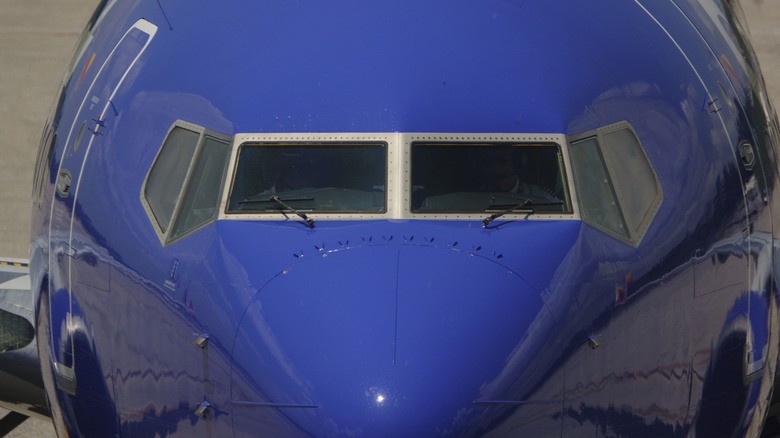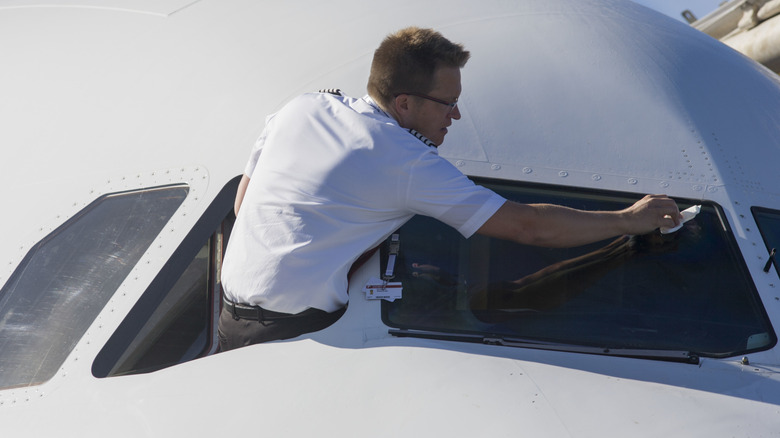How Dangerous Is A Cracked Windshield On A Plane & Can It Cause An Emergency Landing?
Nothing will perturb a nervous flier quite like learning that an aircraft has sustained some damage or there's a technical problem. Such issues, however, can vary in severity. Some of them may be a temporary harmless imbalance that the system will correct automatically, while others are major mechanical problems that necessitate an emergency landing. When it comes to the windshield of a plane, whether damages sustained require an emergency landing also depends on the severity of those damages.
One example of this occurred in October 2025, when U.S. Defense Secretary Pete Hegseth was flying back to the United States from a NATO meeting in Brussels. The aircraft Hegseth was flying on, which was a military version of the Boeing 757 jet called the C-32, had a crack in its windshield and was diverted en route. Ultimately, the plane made an unplanned landing in the United Kingdom. Pentagon Chief spokesman Sean Parnell posted on X that "The plane landed based on standard procedures and everyone onboard, including Secretary Hegseth, is safe."
The C-32 landed at the Royal Air Force's RAF Mildenhall base in the east of England. Prior to doing so, it had been emitting an emergency signal and flying at a reduced altitude of approximately 10,000 feet. As such, it's clear that a cracked windshield can indeed cause an emergency landing. However, plane windshields are designed to be extremely resilient to damages.
Plane windshields have multiple layers of protection
Windshield damage can run the gamut from a slight scratch to a long, spidery crack. Many drivers, unfortunately, have seen these occur on their vehicles. Yet though an airplane windshield has a lot in common with that of a car or other vehicle, they are not engineered in quite the same way. In fact, the windows of an aircraft are made from acrylic rather than glass. As veteran pilot Captain Lim Khoy Hing explains on his website Ask Captain Lim, "The outer pane is made of stretched acrylic plastic to withstand the pressurization load. If it cracks, the middle pane will take the load as this pane act[s] as a fail-safe layer."
To be clear, it's incredibly dangerous if an airplane window breaks, but this design helps prevent them from shattering in the first place. Because the windshield of an aircraft is constructed from more than one sheet of materials, it may not be an immediate emergency for an outer one to sustain a crack. Such aircraft can make safe landings, but will typically divert and land sooner. There is potential, after all, for a pilot or other crew member in the cockpit to be injured if something does strike and penetrate the windshield, as was the case with United Airlines flight 1093 in October 2025. This plane had departed from Denver and was on its way to Los Angeles when it collided with an object, injuring the pilot and breaking the glass.
There have been several occurrences of cracked windshields on planes
In February 2025, Secretary of State Marco Rubio's travels were interrupted by a similar incident. He had been flying to attend the Munich Security Conference but was forced to land back in the United States because there had been a crack in the windshield of his aircraft. Rubio continued on his journey with a separate plane.
Another incident occurred on a Delta Air Lines flight from Atlanta to Los Angeles in May 2014. The cockpit was adversely affected by the pressure of the high altitude and ultimately shattered, resulting in the plane redirecting to Albuquerque, New Mexico instead. However, just the outside layer of the windshield was destroyed, meaning cabin pressure remained stable. A spokesperson for Delta told Oklahoma's News 4 that additional layers of airplane windshields help keep travelers safer in such scenarios, stating, "This is a rare occurrence but the established procedure is to divert." This suggests maintenance is key, as even minor damage could become something considerably worse if not treated promptly.
Former US Airways captain John Cox confirmed in USA Today's Ask The Captain column that in response to a crack, "pilots will descend to reduce the pressure and plan on a diversion if necessary." Nonetheless, the former captain explained, aircraft are designed so that a single pane of the windshield can withstand all the pressure of the altitude. Such measures help ensure flying remains one of the safest ways to travel.


